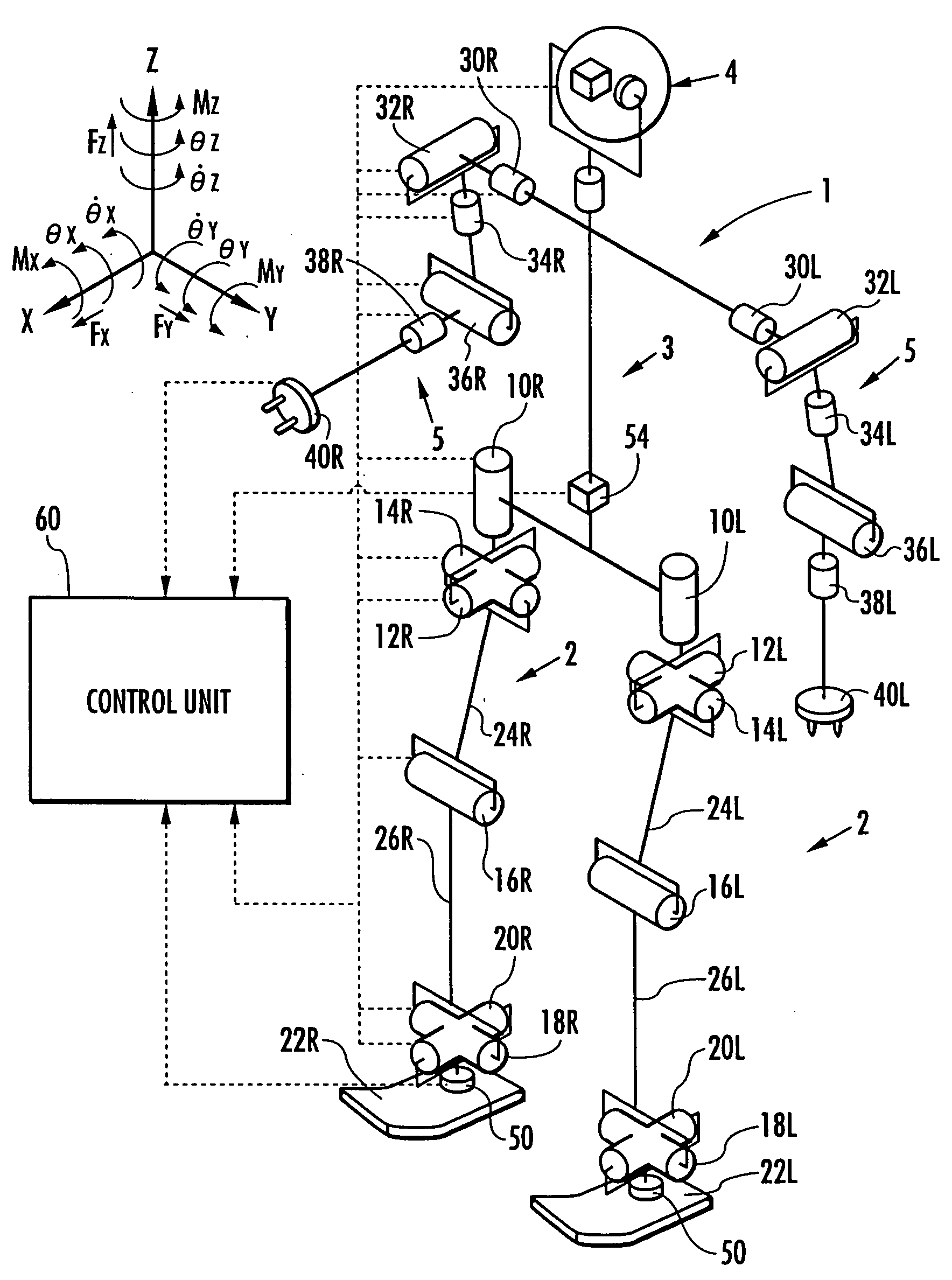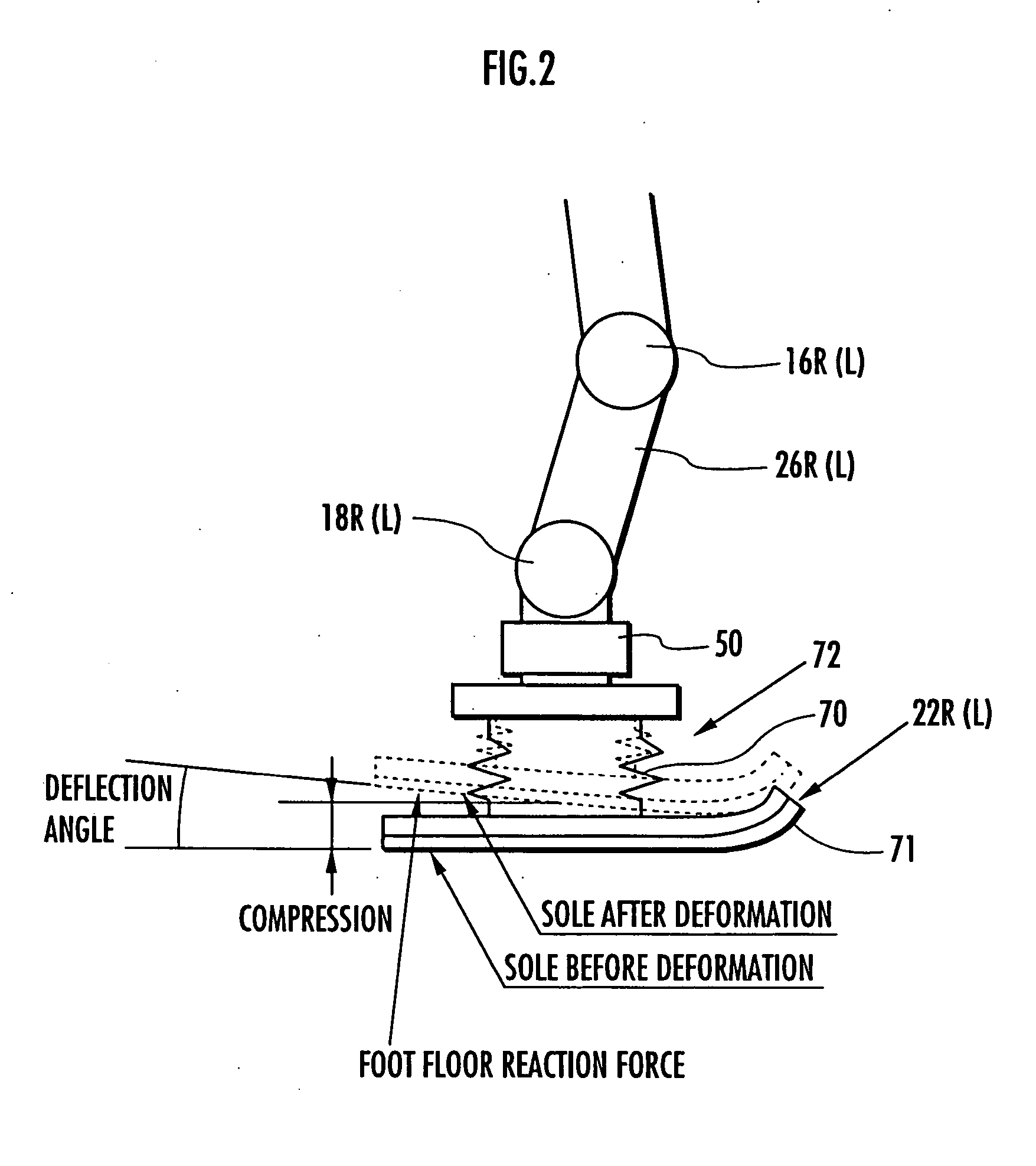Gait generating device of legged mobile robot and legged mobile robot controller
a mobile robot and generating device technology, applied in the direction of electric programme control, program control, instruments, etc., can solve the problems of limited walking definition, inability to clearly distinguish between walking and running, and prone to misinterpretation of gait, so as to achieve high dynamic accuracy
- Summary
- Abstract
- Description
- Claims
- Application Information
AI Technical Summary
Benefits of technology
Problems solved by technology
Method used
Image
Examples
first embodiment
[0338] The first reference example of the present invention does not use a linear dynamic model with three mass points used in PCT Kokai publication WO / 02 / 40224. Nevertheless, the concept of the divergent component and a convergent component defined by the equation given below can be applied with adequate approximate accuracy to a perturbation of a behavior of a nonlinear dynamic model such as the one shown in FIG. 12.
Divergent component=Body mass point horizontal position+Body mass point horizontal velocity / ω0 Equation 10
Convergent component=Body mass point horizontal position−Body mass point horizontal velocity / ω0′ Equation 11
[0339] where the body mass point horizontal position in this case indicates a body mass point horizontal position Xb in the dynamic model shown in FIG. 12.
[0340]ω0 and ω0′ take predetermined values. The values of these ω0 and ω0′ are substantially the same, although they do not exactly coincide. Further, the values for generating walking gaits in PCT Kokai...
third embodiment
[0979] Since the construction other than the processing of S3536 is the same as that of the third embodiment, the explanation thereof will be omitted, and the following will explain the processing of S3536 in detail in conjunction with FIG. 72.
[0980] In S3536, first, as previously described, a correcting perturbation model horizontal body position Xc, which will be discussed later, calculated at the last time control cycle (time t−Δt) is added by a calculator 205 to an instantaneous value of a desired horizontal body position of a simplified model gait determined in S3532 of FIG. 66, thereby determining a final desired horizontal body position (corrected desired horizontal body position) Further, a correcting perturbation model body posture inclination angle θc, which will be discussed later, calculated at the last time control cycle (time t−Δt) is added by a calculator 204 to an instantaneous value (a provisional instantaneous value determined in the control cycle at current time t...
second embodiment
[1017] In the second embodiment, Mafdmd does not steadily become zero; however, if this is steadily set to zero, then an embodiment of the fourth invention in the present invention will be constructed.
[1018] A third embodiment according to the present invention will now be explained with reference to FIG. 74 and FIG. 75. The third embodiment is based on a technique that generates a gait while correcting the gait by using a forward dynamic model (to be more precise, a pseudo forward dynamic model) in place of the inverse dynamic full model (inverse full model) 201 used in the aforementioned first and second embodiments.
[1019]FIG. 74 is a functional block diagram explaining an operation of a device according to the third embodiment. As shown in FIG. 74, the present embodiment is provided with a pseudo forward full model (pseudo forward dynamic full model) 222.
[1020] The pseudo forward full model 222 receives the required value Mpfdmd of horizontal body position stabilization moment,...
PUM
 Login to View More
Login to View More Abstract
Description
Claims
Application Information
 Login to View More
Login to View More - R&D
- Intellectual Property
- Life Sciences
- Materials
- Tech Scout
- Unparalleled Data Quality
- Higher Quality Content
- 60% Fewer Hallucinations
Browse by: Latest US Patents, China's latest patents, Technical Efficacy Thesaurus, Application Domain, Technology Topic, Popular Technical Reports.
© 2025 PatSnap. All rights reserved.Legal|Privacy policy|Modern Slavery Act Transparency Statement|Sitemap|About US| Contact US: help@patsnap.com



